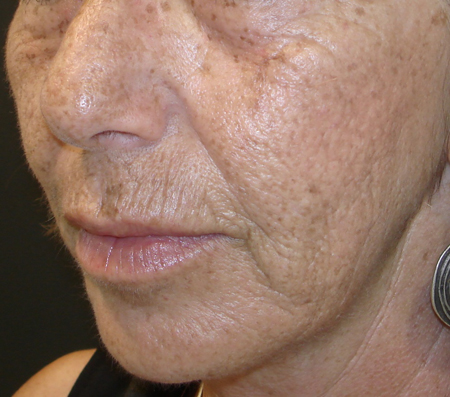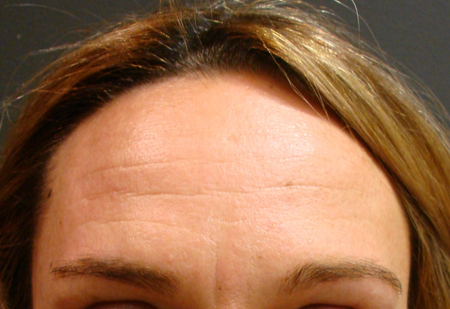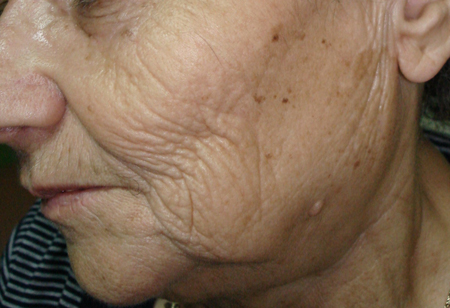Aetiology
Wrinkles occur progressively on the skin surface, secondary to a variety of intrinsic and extrinsic factors.[5] Epidemiological studies have demonstrated that age, the number of pack-years smoked, and UV exposure independently contribute to wrinkle formation and premature skin ageing.[1][6][7] Thin skin, paucity of subcutaneous fat, and sex play an important role in the overall severity of wrinkles.
Physiological chronological skin ageing is the main aetiology of wrinkles, although genetic factors may influence the location and shape of facial creases. The role of genetically programmed chronological ageing is controversial. However, evidence can be found in the literature that human ageing has a hereditary component, and that the age of onset and rate of progression of skin ageing largely depend on genetic factors.[8][9] Intrinsic ageing is an inevitable, genetically programmed process, of unclear underlying mechanism, for which no prevention is available.[10] Moreover, the natural ageing process first appears as invisible changes at the level of the DNA.
Extrinsic ageing is a dynamic process, influenced by such factors as chronic sun exposure (the major environmental factor contributing to photoageing and secondary wrinkle formation), smoking, poor nutrition, excessive alcohol consumption, a low BMI, and pollution.
Cigarette smoking is a significant exogenous factor linked to increased facial wrinkling and accelerated ageing of both sun-exposed and protected areas of skin.[1][11][12] The cumulative tobacco dose has been shown to significantly influence both the number of elastic fibres and the percentage of the area these fill in the reticular dermis.[11]
Hyperdynamic muscular facial activities and progressive loss of underlying soft-tissue support may also induce skin folds and accentuate cutaneous laxity and wrinkling. Repetitive contractions of muscles responsible for facial expression pull directly on the overlying tissues, causing the skin to fold and develop dynamic lines. Among the first lines to develop (by the third decade) are the horizontal forehead creases, caused by contractions of the frontalis muscle, and the lateral canthal or 'crow's feet' lines, caused by contractions of the orbicularis oculi muscle. Glabellar frown lines develop at variable ages as a result of the pull of the procerus and corrugator muscles.[5] Chronic contraction of the orbicularis oris muscle induces folds and lines around the mouth, perpendicular to the vermilion border, which become more noticeable in the fifth decade. Forceful contraction of the zygomaticus muscles contributes to the formation of the nasolabial folds.[Figure caption and citation for the preceding image starts]: 50-year-old woman with photo-aged skin showing advanced wrinkles, discoloration of the skin, actinic keratoses, and dynamic forces affecting the skinFrom the personal collection of Dr Dimitrios Dionyssiou; used with permission [Citation ends]. [Figure caption and citation for the preceding image starts]: 30-year-old woman with mild wrinkles showing few wrinkles at restFrom the personal collection of Dr Dimitrios Dionyssiou; used with permission [Citation ends].
[Figure caption and citation for the preceding image starts]: 30-year-old woman with mild wrinkles showing few wrinkles at restFrom the personal collection of Dr Dimitrios Dionyssiou; used with permission [Citation ends]. [Figure caption and citation for the preceding image starts]: 30-year-old woman with mild wrinkles showing moderate wrinkles on major facial activityFrom the personal collection of Dr Dimitrios Dionyssiou; used with permission [Citation ends].
[Figure caption and citation for the preceding image starts]: 30-year-old woman with mild wrinkles showing moderate wrinkles on major facial activityFrom the personal collection of Dr Dimitrios Dionyssiou; used with permission [Citation ends].
Pathophysiology
Advanced age and solar damage are the most important factors leading to wrinkle formation. The changes associated with chronologically aged skin are distinct from those resulting from sun exposure.
As in all tissues and organs, the skin undergoes characteristic alterations with advanced age. Morphological changes associated with chronologically aged skin result in cutaneous laxity and fine wrinkling, and become evident primarily on the face. Ageing skin demonstrates a progressive loss of thickness, beginning with a thinning of the epidermis and the flattening of the dermoepidermal junction. Significant alterations leading to atrophy mainly occur in the dermis.[13] The total number of fibroblasts, and the amount of ground substance and eosinophilic material decreases with age.[5][14] Progressive reduction of the elastic fibres and changes in collagen components result in decreasing cutaneous tensile strength.[15] The dermal microvasculature progressively diminishes and reduced sebaceous gland activity contributes to an increase in skin dryness.[5][16] These histological changes make the skin inelastic, lax, and prone to wrinkling. Subcutaneous tissues (fat, muscle, bone) also demonstrate progressive atrophy with age, causing the overlying skin to hang from points of deep attachments, and contributing to further accentuation of skin folds. Gravitational lines represent the combined influence of atrophy and gravity on aged skin. They become more obvious between the ages of 40 and 50 years, and occur throughout the face and neck.[17][Figure caption and citation for the preceding image starts]: 80-year-old woman with severe wrinkles, photoageing, and gravitational forces affecting the skinFrom the personal collection of Dr Dimitrios Dionyssiou; used with permission [Citation ends].
Photoageing does not accelerate the normal ageing process, but the effects of UV radiation superimpose upon those of ageing, and many of the skin alterations that decline with age show an accelerated decline in photodamaged skin.[18]
White skin is more susceptible to chronic actinic damage and photoageing. Skin types I to III on the Fitzpatrick classification consistently exhibit greater risk for developing the long-term effects of sun exposure.[4] Actinic damage caused by ultraviolet (UV)-A and UV-B injury to the dermis and epidermis results in the impairment of skin collagen and elastin organisation, and accentuates wrinkling over sun-exposed areas of the body.[19] The most striking feature of chronic actinic damage is dermal elastosis, characterised by the presence of massive quantities of thickened elastic fibres in the dermis. Histological changes include disorganisation of collagen bundles and clumping of elastic fibres, as well as increases in melanin production and the number of inflammatory cells. The skin progressively becomes atrophic, inelastic, lax, depigmented with a yellow hue, and wrinkled with telangiectasia, a leathery appearance, and cutaneous malignancies.
The mechanisms responsible for the deleterious effects and cutaneous alterations associated with cigarette smoking are not clear. Smoking causes a marked reduction in the production of new collagen, the main structural protein of the skin, which maintains skin elasticity, and may acutely decrease arteriolar blood flow in the cutaneous microcirculation, resulting in chronic ischaemia of the dermis.[20][21][22] It has also been hypothesised that smoking decreases vitamin A levels, which protect against oxygen radicals (oxidation) that damage DNA and connective tissue.[23] Tobacco smoke in the environment promotes dryness of the skin surface and reduces blood flow to the skin, resulting in the depletion of oxygen and essential nutrients.[24][25][26]
Exposure to air pollution may start a cascading process that results in the formation of free radicals. Free-radical damage causes wrinkles by activating metalloproteinases that break down collagen.
Use of this content is subject to our disclaimer